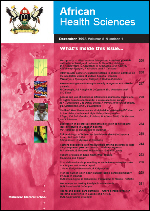
|
African Health Sciences
Makerere University Medical School
ISSN: 1680-6905
EISSN: 1680-6905
Vol. 16, No. 1, 2016, pp. 36-43
|
 Bioline Code: hs16006
Bioline Code: hs16006
Full paper language: English
Document type: Research Article
Document available free of charge
|
|
|
African Health Sciences, Vol. 16, No. 1, 2016, pp. 36-43
| en |
Vitamin D status in the first-trimester: effects of Vitamin D deficiency on pregnancy outcomes.
Ates, Seda; Sevket, Osman; Ozcan, Pinar; Ozcal, Fulya; Kaya, Mehmet Onur & Dane, Banu
Abstract
Objective: To assess serum levels of 25-hydroxyvitamin D [25(OH)D] in the first trimester and to determine the factors affecting deficiency levels and its association with pregnancy outcomes.
Methods: Serum 25(OH)D concentrations were measured at 11-14 weeks’ gestation in 229 singleton pregnancies using liquid chromatography-tandem mass spectrometry.
Results: The median serum 25(OH)D concentration was 10.8 ng/mL and 45.9% of women had severe vitamin D deficiency with concentrations of <10 ng/mL. Logistic regression analysis revealed that covered dressing style, lack of multivitamin intake, season of blood sampling (November-April) were factors associated with 25(OH)D deficiency. There was a negative correlation between 25(OH)D levels and gestational age at sampling. Low 25(OH)D levels were not associated with adverse pregnancy outcomes. Higher rate of cesarean section (CS) was noted in women with 25(OH)D ≥10 ng/mL compared to those with 25(OH)D < 10mg/ml ( p= 0.01).
Conclusion: A high prevalence of vitamin D deficiency was observed in early pregnancy which was related to dress code, use of multi-vitamins and season at sampling. Low 25(OH)D levels were not related with adverse pregnancy outcomes. Women with severe vitamin D deficiency were more likely to deliver vaginally.
Keywords
25-hydroxyvitamin D; pregnancy outcome; vitamin D deficiency
|
| |
© Copyright 2016 - African Health Sciences
|
|
